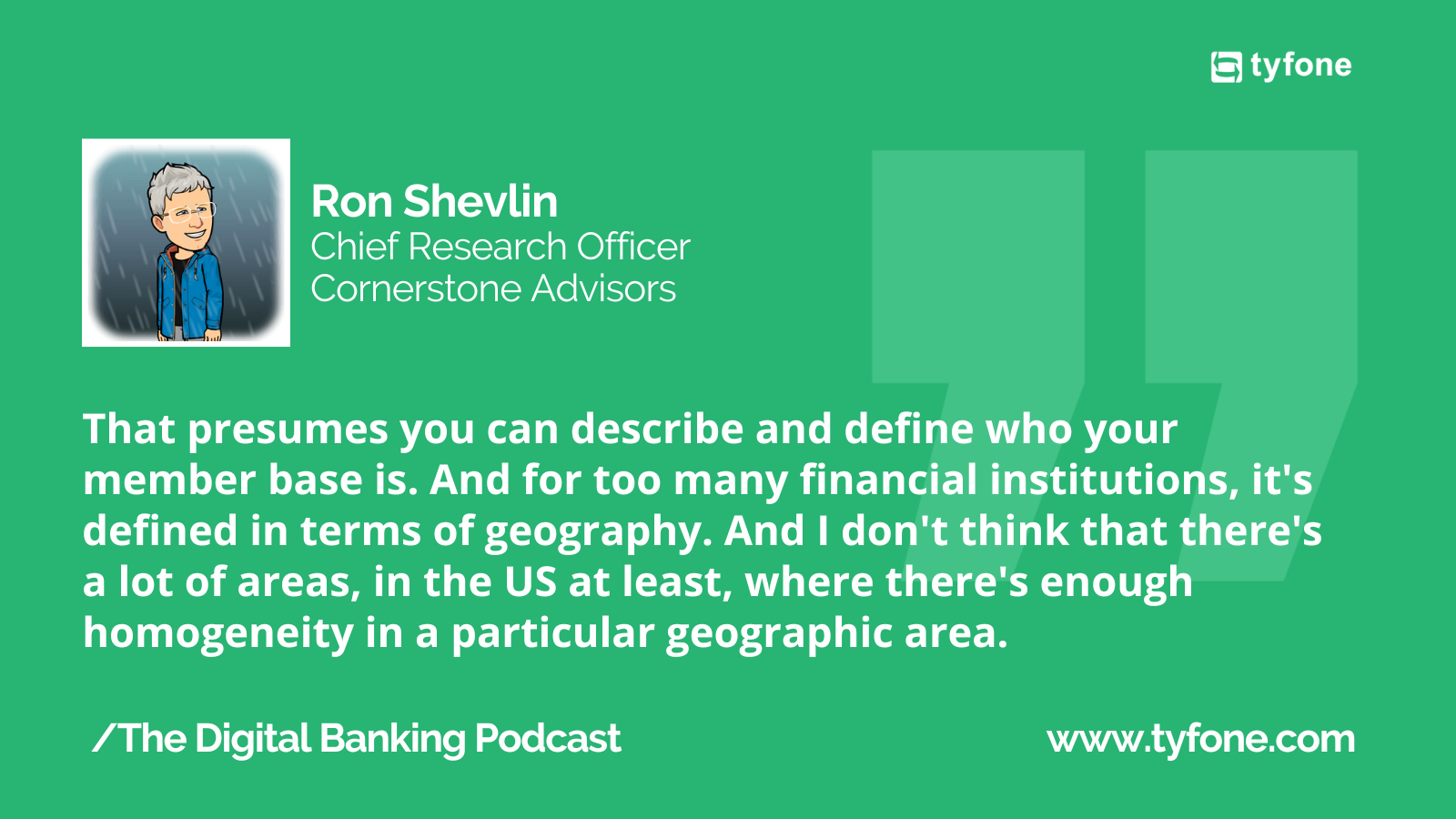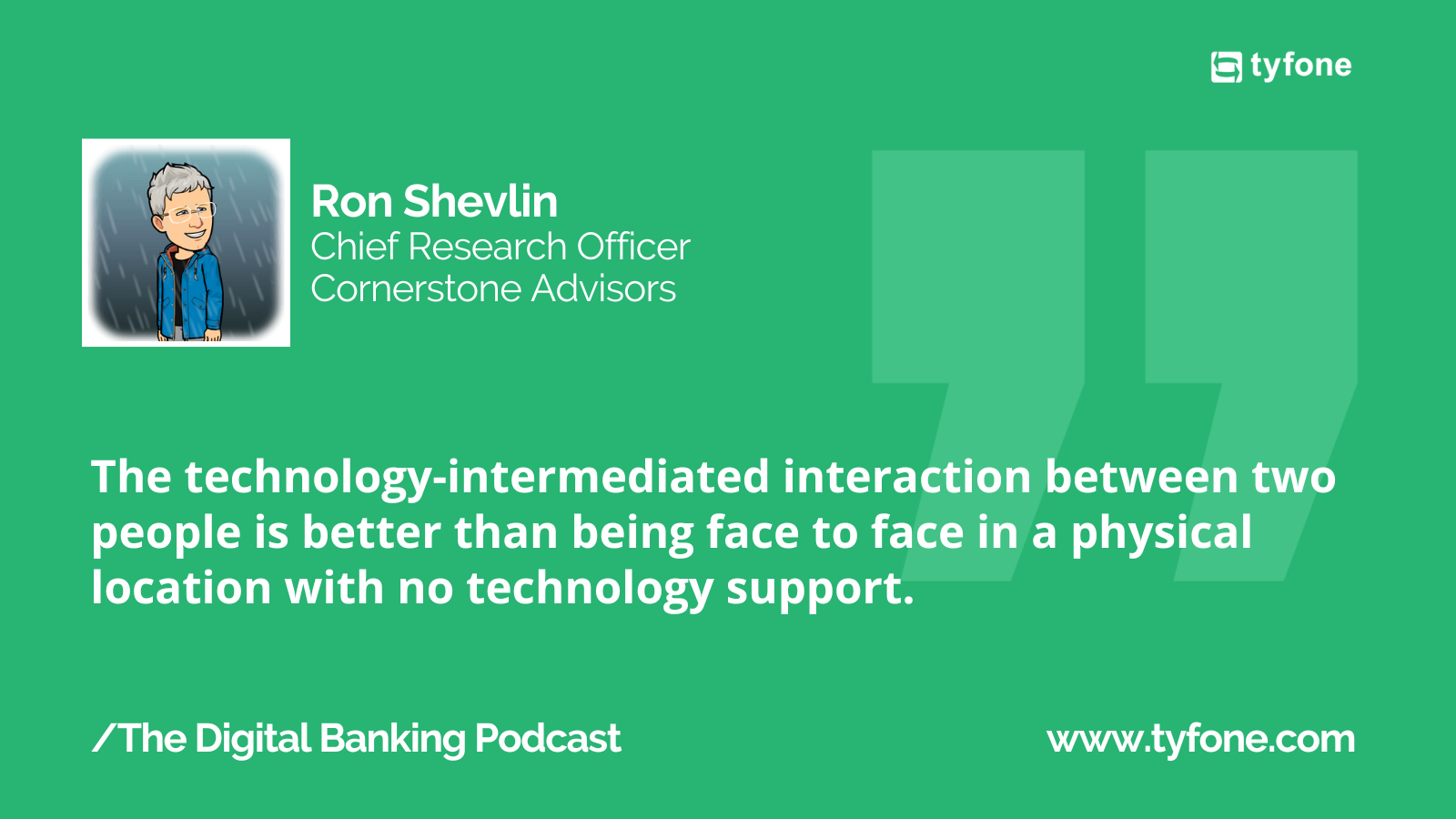Disruption, Transformation and Strategy, with Ron Shevlin
- If you want to work on the digital transformation of your financial institution, focus on digitizing the infrastructure, not the culture.
- As an FI, you have to know who your accountholders, but define them by something other than geography. FIs should be needs driven.
- In a time when we can’t imagine anything without technology, the technology-mediated interaction between two people is better than being face-to-face in a physical location without technology support.
Everybody agrees that financial institutions need digital transformation. Nobody agrees what that means. Many people in the industry mistakenly believe that it is about changing the culture when, in fact, it is about improving the technological infrastructure.
Ron Shevlin, Chief Research Officer at Cornerstone Advisors, explained the digital transformation process by comparing it to re-engineering.
“It’s a management buzzword that doesn’t mean anything, and it means everything. About 25 years ago, long before any of these fintechs were even around – many of them were probably in elementary school at the time – there was a book written by a couple of Harvard Business School professors called Beyond the Hype. And even back in the mid-nineties, they were looking at all these management fads and trends that were going on. We had gone through re-engineering and business process redesign, and knowledge management, and things that had happened before that, and this was all pre-dot.com.”
According to Shevlin, one of the reasons management fads or management trends take hold is that they’re often so imprecisely defined, it allows managers, executives, and whole companies to adopt the label and define it for themselves.
“Re-engineering was a good example that started off as something that was supposed to be about redesigning business processes to make them more efficient and effective and evolved to become a buzzword and synonym for layoffs. And digital transformation is the same thing in the banking industry,” claimed Shevlin.

Fintechs Are Not Building Features for Feature’s Sake
Shevlin said that fintechs don’t build features for the sake of building features; they build features to fix problems.
“For most financial institutions, whether it’s large or small, mid-sized financial institutions, they’ve grown to the point where they have multiple lines of business, various products, and services that they offer, and simply can’t generate enough growth by offering a small fix, like what a fintech or a startup might be offering,” said Shevlin.
He went on to explain why a focus that is too narrow is not good for business. “Look at even Robinhood and all these others who have gotten into the market with some product or service and have started to expand, looking more like a fully formed financial institution. So the problem isn’t that they’re building technology for technology’s sake there. The problem is that too narrow a focus is generally not a sustainable business model.”
Redefine Strategy, Not Data
Data is data. You can’t change data. However, you can change your strategy to address and benefit from the data.
“It’s about what niche of the market you are going to serve and own. Historically, that’s always been or has been driven very much by geography. ‘We’re gonna carve out this section of the market and own it.’ As a result of the internet at large, that has changed where, regulatorily speaking, there are those geographic barriers, but those can be overcome,” said Shevlin.
He added that financial institutions must understand that what differentiates them is always something related to the product or service line.
“A lot of mid-size banks and credit union executives have to wake up to the harsh reality that, as hard as it is for them to accept, their people are not any better than every other financial institution’s people; their customer or member services are not any better than everybody else’s,” concluded Shevlin.

A Chatbot Should be Treated as an Employee
According to Shevlin, the key to technological success is to treat the new chatbot or intelligent digital assistant as an employee and as part of the team.
“You have to train them; you have to onboard them; you have to have a development plan for them, just as any potential management training program that you had with employees,” claimed Shevlin.
“I had a reporter, about a year ago or so, call me and ask me, ‘Is it conceivable that a bank or credit union could have no people and simply be run by AI?’ And I was like, I couldn’t see my way to a yes answer on that one,” said Shevlin, “but I guess there might be people who would argue, yeah, sure, that’s possible. It doesn’t feel feasible to me, but maybe that’s just the ultimate path and not maybe 10 years from now, and maybe not even 20, but 50 years from now, which I know is hard for people to think about.”
The higher value transactions, which are more complex, conceptually should be better done with technology than with people because people are limited in the amount of data they can process and the speed with which they can process it. “Yes, we have experience, but that’s what you get after 20 years of deploying the technology; it is the history,” noted Shevlin. “And so, I think we go down a path where it isn’t about offloading transactions to chatbots and robots for the lower value stuff; it’s probably better we’ll have them do the higher value stuff.”.
The Importance of Building a Sustainable Business Model
Shevlin pointed out that it’s not just the major disruptors that have an impact.
“If we look at the past 40, 50 years of technology development, who have been the super huge disruptors? Apple and Microsoft, in the transition from the mainframe to the PC era. And Google, not Yahoo, Google, and Amazon, in the transition to the internet era. But that’s not to say that nobody else had an impact. They’ve had a huge impact, but there’s only so many Googles, Amazons, Microsofts, and there’s only room for one or two,” said Shevlin.
He added that for many fintechs, the real goal is to build sustainable businesses, not disruption.
“For many of them, building a sustainable business will mean being acquired or acquiring others to create a fuller set of solutions versus functions. But that’s not to downplay their role in the change of things. The problem is in the use of the words disruption and disruptors. And in fact, if you really want to get technical about it and go back to the whole innovators’ dilemma, Clayton Christensen thing, it isn’t companies that are disruptive. It’s technologies that are disruptive,” concluded Shevlin.

